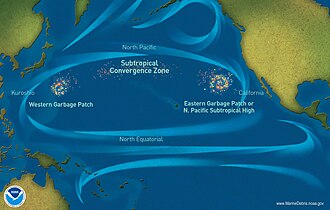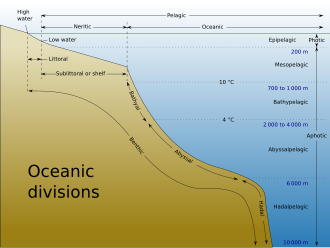Rebecca Helm
Appearance
Dr. Rebecca R. Helm is an Assistant Professor of Biology at the University of North Carolina, Asheville, and a Postdoctoral Researcher at the Woods Hole Oceanographic Institution.
Quotes
[edit]

- There are few contemporary reviews of whole-ocean neuston ecosystems. I started with smaller studies on specific animals and worked my way through their references. One reference, in Russian Cyrillic, came up again and again. This made sense. I knew the United States and the U.S.S.R. had both developed extensive oceanographic-research programs after World War II, but each region published in its own language, making overlap difficult. I sat with a librarian for nearly an hour, hunting this study down. Finally, we found it: a 1956 study published in the U.S.S.R., in Russian, by an oceanographer named A. I. Savilov. This led us to another study of his from 1968, mercifully translated into English. Savilov spent his career studying the neuston by conducting extensive surveys all across the Pacific and synthesizing this work into a map of the open-ocean surface ecosystems. Savilov described seven unique neuston meadows in the open ocean, each with its own unique composition of animals. Just as rainforests differ from temperate forests, these neustonic ecosystems are unique.
- “How Plastic Cleanup Threatens the Ocean’s Living Islands”, The Atlantic, (Jan 22, 2019)
- The Ocean Cleanup was founded with the vision of clearing the world’s ocean of Plstic. The project’s goals are ambitious, and it plans to launch approximately 60 systems to reduce “the amount of plastic in the world’s oceans by at least 90% by 2040.” It is starting with what’s known as the Great Pacific Garbage Patch, but is already scoping out other targets, too.
Even without an environmental-impact assessment, it’s easy to imagine what will happen if the Ocean Cleanup succeeds. Neuston and plastic co-occur: They’re in the exact same spots. Cleaning up 90 percent of the plastic using the current method means potentially destroying 90 percent of the neuston.
This reality is built into the project’s design. Plastics mimic the neuston world—it’s buoyant, surface bound, and rubbery. When wind and ocean currents sweep neuston through the project’s barrier, animals such as blue sea dragons will be corralled and confined in a huge trap, their fragile bodies colliding with hard and jagged surfaces. They cannot sink below or swim around. They will be suffocated, crushed, and hauled to landfills.
The fact that we don’t have a solid understanding of the neuston ecosystem is even more worrying: We will have very little “before” data to compare the Ocean Cleanup’s impact against.- “How Plastic Cleanup Threatens the Ocean’s Living Islands”, The Atlantic, (Jan 22, 2019)
- The Ocean Cleanup says it wants to protect animals at the ocean’s surface from plastic, but neuston is the ecosystem of the ocean’s surface. There is a reason turtles and sunfish eat floating surface plastic: It looks like neuston. Using these wall-like barriers to collect plastic in spite of the neuston is like clear-cutting a canopy in the name of helping a forest. There is no point in collecting plastic if by the end there is nothing left to conserve.
- “How Plastic Cleanup Threatens the Ocean’s Living Islands”, The Atlantic, (Jan 22, 2019)
- There are some mysteries so big that they will take the whole world to solve them.
- In a Twitter post, quoted in You Can Help Solve One of the Mysteries of the Ocean (April 24, 2019) by Chantel Delulio, Fodor's
- There's still so much we don't know about these creatures. But if glitter worms teach us anything, it's that even in the harshest places there is still wonder and beauty. Times are tough, but never forget the awe and majesty of life on this strange blue planet.
- In a Twitter post, quoted in Newly discovered 'glitter worms' dance and fight one another underwater (May 14, 2020) by Bonnie Burton, CNET
External links
[edit]- Official website
- Rebecca Helm at The Conversation
- Rebecca Helm at Google Scholar
- Rebecca Helm at ResearchGate
- (27 December 2017)"Indoles induce metamorphosis in a broad diversity of jellyfish, but not in a crown jelly (Coronatae)". PLOS One 12 (12): e0188601. DOI:10.1371/journal.pone.0188601.
- (1 November 2019)"Environmental entrainment demonstrates natural circadian rhythmicity in the cnidarian Nematostella vectensis". The Journal of Experimental Biology 222 (21): jeb205393. DOI:10.1242/jeb.205393.
Cited
[edit]- Experts warned this floating garbage collector wouldn’t work. The ocean proved them right. (January 17, 2019) by Ben Guarino, The Washington Post
- Ethereal ‘Sea Angel’ Slug Looks Like CGI Alien (February 5, 2020) by Matthew Hart, Nerdist Industries
- What The Heck Is This Long, Hypnotic Stringy Thing Floating in The Ocean? (8 April 2020) by Tessa Koumoundouros, ScienceAlert
- Watch: The scientific reason why baby octopuses ride jellyfish by Nina Pullano, Inverse
- Bioluminescent Waves on California Coast have Turned into Red Tide that Smells Like Sulfur: Why is That? (May 13, 2020), Science Times
- Newly Identified Fish Nurseries Are Choked With Plastic (November 12, 2019) by Jason Daley, Smithsonian